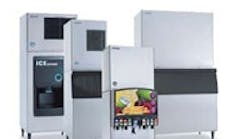The key to getting maximum performance out of an ice machine is proper installation, which ideally follows an initial site inspection. In an ideal situation, this step is completed by the salesman prior to quoting the ice machine. This information is then provided to the installer. If not, this step should be done by the installer prior to beginning the installation.
Site Survey Points
An initial site inspection will ensure that utilities are available and that the unit won’t be subjected to external influences that will affect proper ice machine operation. It is advisable to create a site survey check sheet, which shows the utility locations along with other specifics so that no important items are overlooked. It will also allow the installer to know what materials will be needed in preparation for the installation.
Three specific things are necessary to connect the ice maker: proper power supply, adequate water supply, and adequate drainage.
1. Proper power supply: An ice machine requires an independent (separate) circuit of adequate voltage and amperage. Depending on the unit size, it may have a standard plug connection or require a hard wire connection to a junction box, or in some cases, a separate disconnect. It’s important to know the voltage power requirements of the unit you will install, and to check the circuit wiring and breaker to ensure they’re sized properly for the applicable unit.
2. Adequate water supply: The water requirements of the ice machine are another important factor that should be checked.
- Make sure there is a water supply connection at the site that will provide adequate water flow to the ice maker. The water supply should be traced back to the source to ensure that there are no restrictions to the water flow that could cause a short supply of water to the unit.
- If the supply is taken off of a trunk line, make sure that the trunk is sized appropriately so that the ice maker will not run short of water when other equipment is operating.
- If water filter or treatment system will be installed or is present, ensure that the filter system is sized appropriately for the ice maker application. The filter flow rate and header size are important as well as the inlet water line size.
3. Adequate drain: Both the ice maker and the storage bin will require a drain line connection. If a floor drain is near, make sure it’s accessible and is open for proper drainage. If not, locate a drain point and decide the best route to ensure proper drainage for the unit.
Miscellaneous issues: Adequate clearance, ventilation and ambient conditions are also important for proper ice maker operation.
- Ensure the location will provide a minimum of 6-in. clearance around the unit for airflow and serviceability.
- The customer will need room to access the storage bin for ice removal. Make sure there is adequate clearance in front of the unit to fully open the bin door.
- Next, make sure the site is away from external heat sources and has adequate ventilation. Ventilation is especially important to remove the condenser heat if the ice maker is air cooled.
- In general, ice makers are not designed for outside installation, so the customer should be discouraged from locating the unit outside, where it will be exposed to the elements.
- A remote condenser unit requires room on the roof to mount the condenser, and adequate clearance for air flow and serviceability. A roof curb to support the condenser may be provided by the builder or installer. A roof penetration is also required to run the control circuit and refrigerant lines. In general, roof penetration is provided by a bonded roofer. There may be other factors, however, these are common issues that should be noted for a proper ice machine installation.
Danny Moore is director of technical support for Hoshizaki America, Inc., a manufacturer of commercial ice equipment and reach-in refrigeration. Visit www.hoshizakiamerica.com for additional information












